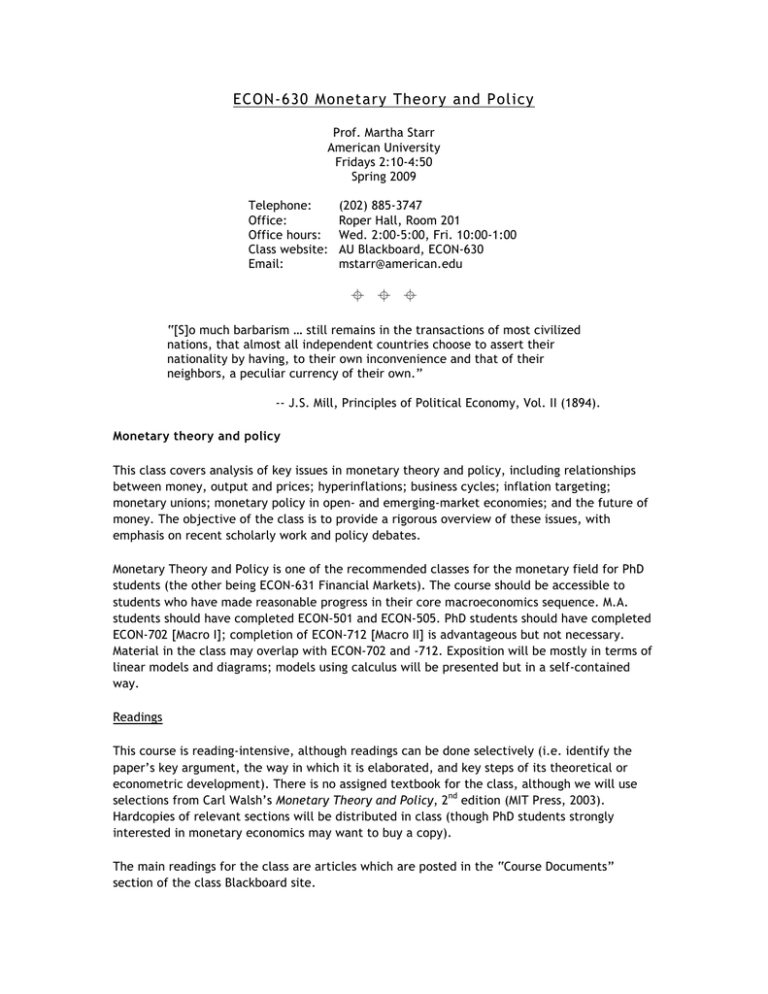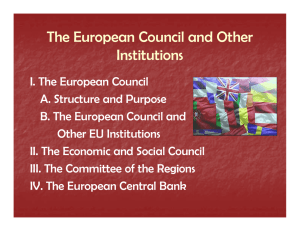ECON-630 Monetary Theory and Policy
advertisement

ECON-630 Monetary Theory and Policy Prof. Martha Starr American University Fridays 2:10-4:50 Spring 2009 Telephone: Office: Office hours: Class website: Email: (202) 885-3747 Roper Hall, Room 201 Wed. 2:00-5:00, Fri. 10:00-1:00 AU Blackboard, ECON-630 mstarr@american.edu “[S]o much barbarism … still remains in the transactions of most civilized nations, that almost all independent countries choose to assert their nationality by having, to their own inconvenience and that of their neighbors, a peculiar currency of their own.” -- J.S. Mill, Principles of Political Economy, Vol. II (1894). Monetary theory and policy This class covers analysis of key issues in monetary theory and policy, including relationships between money, output and prices; hyperinflations; business cycles; inflation targeting; monetary unions; monetary policy in open- and emerging-market economies; and the future of money. The objective of the class is to provide a rigorous overview of these issues, with emphasis on recent scholarly work and policy debates. Monetary Theory and Policy is one of the recommended classes for the monetary field for PhD students (the other being ECON-631 Financial Markets). The course should be accessible to students who have made reasonable progress in their core macroeconomics sequence. M.A. students should have completed ECON-501 and ECON-505. PhD students should have completed ECON-702 [Macro I]; completion of ECON-712 [Macro II] is advantageous but not necessary. Material in the class may overlap with ECON-702 and -712. Exposition will be mostly in terms of linear models and diagrams; models using calculus will be presented but in a self-contained way. Readings This course is reading-intensive, although readings can be done selectively (i.e. identify the paper’s key argument, the way in which it is elaborated, and key steps of its theoretical or econometric development). There is no assigned textbook for the class, although we will use selections from Carl Walsh’s Monetary Theory and Policy, 2nd edition (MIT Press, 2003). Hardcopies of relevant sections will be distributed in class (though PhD students strongly interested in monetary economics may want to buy a copy). The main readings for the class are articles which are posted in the “Course Documents” section of the class Blackboard site. 2 Graded work The grade for this class will be determined as follows: Contribution to final grade (percent) Due date 12.5 Feb. 20 20 March 6 (take home – class does not meet that night) 12.5 April 17 Research paper (15-20 pages, instructions distributed soon) 25 Apr. 24 (last day of class) Final exam 25 May 1 (take home) Class participation 5 Throughout Item VAR project Midterm Policy debates VAR project In the VAR project, you will be expected to run basic vector-autoregressive analyses using data on monetary-policy variables, output and prices for a country of your choice. The assignment requires you to use Eviews -– a software package that emphases time-series applications and is widely used for analysis of macroeconomic and financial data. There will be a tutorial on Eviews and VARs to help you get started. 3 Course Outline 1. Introduction: Review of monetary-policy basics and background on contemporary issues (Jan. 16-23) Mankiw, “Aggregate Supply and Demand” [hardcopy] Ken Rogoff, “Globalization and disinflation,” Federal Reserve Bank of Kansas City Economic Review, 2003 (Fourth Quarter), pp. 45-78. Frederic S. Mishkin. “Monetary policy strategy: How did we get here?” NBER Working Paper No. 12515 (Sept. 2006). 2. Empirical evidence on money and output (Jan. 23) Carl Walsh, Monetary Theory and Policy, Chapter 1 3. Inflation and growth in the long-run (Jan. 30 – Feb. 6) Carl Walsh, Monetary Theory and Policy, Chapters 2-4. Milton Friedman, "The Role of Monetary Policy," American Economic Review, March 1968. Paul de Grauwe and Magdalena Polan, “Is Is Inflation Always and Everywhere a Monetary Phenomenon?” Scandinavian Journal of Economics, 2005. Stanley Fischer, Ratna Sahay, Carlos Vegh, "Modern Hyper- and High Inflations," Journal of Economic Literature, Sept. 2002. Thomas Sargent, Noah Williams, and Tao Zha. “The conquest of South American inflation” (Dec. 2006). 4. The business cycle: Monetary policy in the short-run (Feb 13) M. AYHAN KOSE, ESWAR S. PRASAD, AND MARCO E. TERRONES (2003). “How Does Globalization Affect the Synchronization of Business Cycles?” American Economic Review (May). Walsh, “Imperfect Information” (the Lucas model) pp. 200-208. Marvin Goodfriend (2004). “Monetary Policy in the New Neoclassical Synthesis: A Primer,” Federal Reserve Bank of Richmond Economic Quarterly, Vol. 90, No. 3 (Summer). Steven Davis and James Kahn (2008). “Interpreting the Great Moderation: Changes in the Volatility of Economic Activity at the Macro and Micro Levels,” Journal of Economic Perspectives, Vol. 22, No. 4 (Fall), pp. 155-80. 5. Time inconsistency and contemporary monetary policy (Feb. 20-27) Barro-Gordon model -– Walsh, pp. 365-378, 393-397. Ben Bernanke and Frederic Mishkin (1997). “Inflation targeting: A new framework for monetary policy?” Journal of Economic Perspectives (Spring 1997). 4 Prof. Starr’s hand-out on the Fed, ECB, and Bank of England Alan Greenspan (2004). “Risk and Uncertainty in Monetary Policy,” American Economic Review, Vol. 94, No. 2 (May), pp. 33-40. Lars Svennson (2008). “Inflation targeting.” New Palgrave Dictionary entry. International Monetary Fund, “Does inflation targeting work in emerging markets?” Ricardo Caballero and Arvind Krishnamurthy (2003). “Inflation targeting and sudden stops”. NBER Working Paper No. 9599 (April). Joshua Aizenman, Michael Hutchison, and Ilan Noy (2008). “Inflation Targeting and Real Exchange Rates in Emerging Markets.” NBER Working Paper No. 14561 (Dec.). 6. Internation aspects of monetary policy: Monetary union, currency competition (Mar. 20-27) Robert Mundell (1961). “A Theory of Optimum Currency Areas,” American Economic Review (Nov.) Alberto Alesina and Robert Barro (2002). “Currency Unions,” Quarterly Journal of Economics. Maurice Obstfeld and Ken Rogoff (2002). "Global Implications of Self-Oriented National Monetary Rules," Quarterly Journal of Economics, Vol. 117 (May), pp. 503-36. The Economist, “Currency competition” Menzie Chinn and Jeffrey Frankel (2008). “Why the Euro will Rival the Dollar,” International Finance, Vol. 11, No. 1, pp. 49-73. 7. Financial frictions and monetary policy (Mar. 27-Apr. 24) (a) Interpreting the Great Depression David Wheelock, “Monetary Policy in the Great Depression: What the Fed Did, and Why,” Federal Reserve Bank of Kansas City Economic Review, Mar/Apr. 1992, pp. 3-28. Bernanke, B. S. (1983), “Nonmonetary Effects of the Financial Crisis in the Propagation of the Great Depression,” American Economic Review, Vol. 73, No. 3, pp. 257-276 (b) Asset price bubbles Ben Bernanke, Mark Gertler (2001). “Should Central Banks Respond to Movements in Asset Prices?” American Economic Review (May). Kevin Lansing (2008). “Monetary Policy and Asset Prices,” Federal Reserve Bank of San Francisco Economic Letter, No. 2008-34 (Oct.). Rudiger Ahrend, Boris Cournede, and Robert Price (2008). “Monetary Policy, Market Excesses and Financial Turmoil.” OECD Working Paper No. 597. Roger Farmer, "How to prevent the Great Depression of 2009" (c) Monetary policy at the zero bound Ben Bernanke, Vincent Reinhart, and Brian Sack (2004). “Monetary Policy Alternatives at the Zero Bound,” Brookings Papers on Economic Activity, Vol. 2. 5 Gauti B. Eggertsson; Michael Woodford (2004). “Policy Options in a Liquidity Trap,” American Economic Review, Vol. 94, No. 2 (2004), pp. 76-79. (d) Systemic financial distress and the role of the central bank M. Starr & R. Yilmaz (2007). "Bank runs in emerging-market countries: Evidence from Turkey's Special Finance Houses," Southern Economic Journal (April). Xavier Freixas and Bruno Parigi (2008). “Lender of Last Resort and Bank Closure Policy,” CESIFO Working Paper No. 2286 (April). Ricardo Caballero and Arvind Krishnamurthy (2008). “Collective Risk Management in a Flight to Quality Episode,” Journal of Finance (Oct.). Tobias Adrian and Hyun Song Shin (2008). “Financial Intermediaries, Financial Stability and Monetary Policy”. Caballero,Ricardo J.; Farhi,Emmanuel; Gourinchas,Pierre-Olivier (2008). “Financial Crash, Commodity Prices and Global Imbalances,” National Bureau of Economic Research Working Paper No. 14521 (Dec.)








